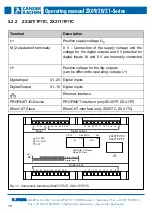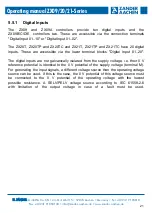
H. ZANDER GmbH & Co. KG • Am Gut Wolf 15 • 52070 Aachen • Germany • Tel +49 241 9105010
Fax +49 241 91050138 • [email protected] • www.zander-aachen.de
22
Operating manual ZX09/20/21-Series
5.5.2 Connection of the digital Inputs
The connection of the digital inputs for the ZX09 series is shown in Figs. 15A and 15B
using the ZX09 / ZX09A controller as an example. The connection of the digital inputs
of the ZX09B/C/D/E controllers is identical, the only difference is the number of inputs.
The connection of the digital inputs of the ZX20/21 series controllers is shown in Fig-
ures 14A and 14B.
Sensors which generate a digital signal can be connected to the terminals "Digital
Input 01..10" or "Digital Input 01..02", here represented by simple switches. These can
be supplied either by the operating voltage source or a separate voltage source. For
the input voltage, a voltage range of 18 to 30 V applies (see chapter 12 "Technical
data"). If a separate voltage source is used, its 0 V output must be connected to the 0
V output of the operating voltage. The signal cable of the sensors can be connected
directly (see Fig. 14A or 15A) or, if fast input signals have to be processed, shielded
(see Fig. 14B or 15B) to the input terminals. If a screened cable is used, the cable
screen must be connected to a screen rail. The cable shield should be connected at
one end as close as possible to the terminal.
It is possible to suppress inputs by software by providing them with a "debounce time"
in the user program via the ".TDB" command. This is helpful when using electrome-
chanical switching elements or input signals with very steep clock edges which cause
overshooting at the input.
Note:
Please observe the permissible voltage range for the digital inputs
(18 - 30 V).
Note:
Detailed information on programming the debounce time can be found in
the programming manual under chapter 2.3.1.1 "VAR_INPUT", which is
included as a PDF file in the software package "EX_PRESS 5" (Art. No.
589092) on the USB stick enclosed there.
















































